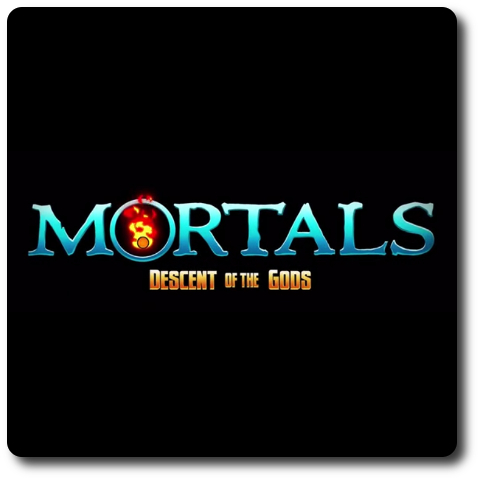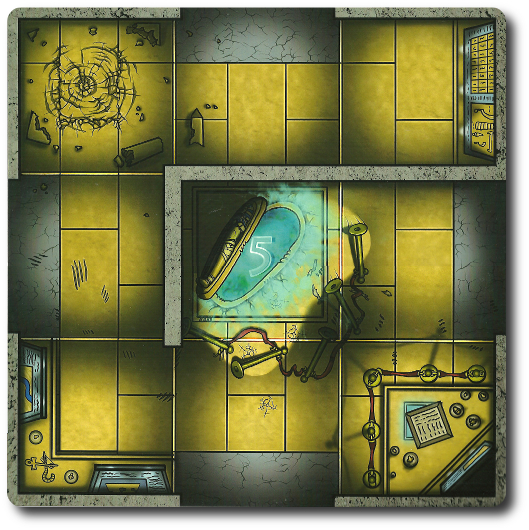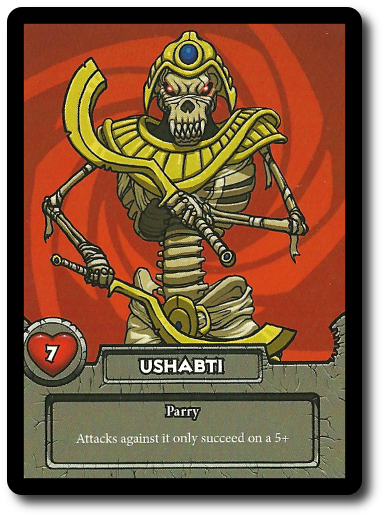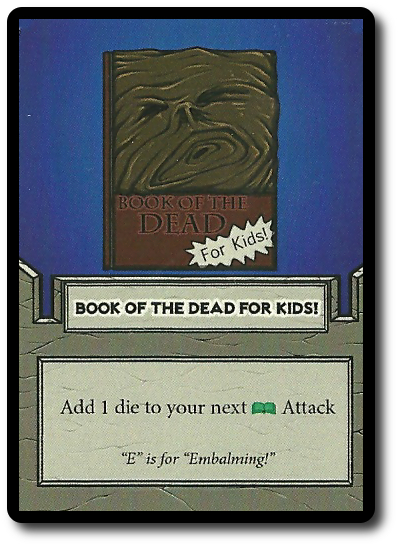Please Take Note: This is a review of the final game, but it might change slightly based on the success of the Kickstarter campaign. The game is being reviewed on the components and the rules provided with the understanding that “what you see is not what you might get” when the game is published. If you like what you read and want to learn more, we encourage you to visit the Kickstarter campaign. Now that we have all that disclaimer junk out of the way, on with the review.

The Basics:
- For ages 10 and up
- For 2 to 5 players
- Approximately 60 minutes to complete
Geek Skills:
- Active Listening & Communication
- Counting & Math
- Logical & Critical Decision Making
- Reading
- Strategy & Tactics
- Cooperative & Team Play
- Hand/Resource Management
Learning Curve:
- Child – Easy
- Adult – Easy
Theme & Narrative:
- Rise above mortality to claim your immortal powers!
Endorsements:
- Gamer Geek approved!
- Parent Geek mixed!
- Child Geek approved!
Overview
The Gods have fallen. They now live among us, stripped of their power and made to humble themselves as they coexist with us mortals. Death, the most fearsome of the Four Horseman of the Apocalypse, has used the absence of the Gods as an opportunity to promote its own agenda. Now humanity is plagued by the undead and all seems lost. But not yet. The Gods may have fallen, but they aren’t down for the count!
Mortals: Descent of the Gods, to be published by Partial Arc, will reportedly be comprised of 12 standard twelve-sided dice, 12 standard six-sided dice, 6 Seal dice, 1 Destroyer die, 1 Free Action die, 12 Character cards, 12 Mythic cards, 35 Monster Spawn cards, 4 Destroyer cards, 3 Influence cards, 30 Legendary Item cards, 60 Common Item cards, 6 board tiles, 12 Character tokens, 12 Mythic tokens, 30 Ghoul tokens, 15 Lich tokens, 4 Destroyer tokens, 73 Token stands, and 11 XP/HP sliders. As this is a review of a prepublished game, I cannot comment on the game component quality.
Welcome to the Museum Battlefield!
To set up the game, first take the board tiles and randomly place them, setting them side-by-side to create a large triangle. These board tiles represent the museum in which the players will be exploring for magical seals and fighting the undead. Each board is broken down into spaces which are separated by thin lines and thick walls.

Second, place one Seal dice in the center of each board tile with the Flame icon face-up. These represent the magical seals that contain the immortal power of the fallen Gods. They are being used as batteries by Death to power its army, but can be claimed by the players during the game to unlock new abilities.
Third, separate the cards into three different decks. These will be the Monster deck, the Legendary Item deck, and the Common Item deck. Shuffle each deck separately and place them face-down next to the board tiles. These will be the draw decks for the duration of the game.
- The Monster cards represent the horde of undead that Death commands and a few rarer and much more dangerous monsters known as Mythics. There is also a chance that the Destroyer (who might or might not be in the game yet) could influence the board tiles.

- The Legendary cards represent artifacts of antiquity and of great power. Only the Gods know of their true potential. Some items have restrictions regarding who can use them. Legendary items also “unlock” when the player’s Character hits God Mode. For example, the “Trident of Olympus” Legendary card gives the Poseidon character the ability to use the Free Action twice per turn.

- The Common cards are every day items any mortal can pick up and use, but become particularly useful in the hands of a god or goddess. Like the Legendary items, some Common items have restrictions regarding who can use them. For example, the ever popular “Book of the Dead for Kids!” Common card is only useful if the player’s Character uses magic. Once used, Common items are discarded.

Third, have the players select the God or Goddess they want to play as. The Gods come from the Greek, Norse, and Egyptian mythos. Each Character card details the God’s or Goddess’s special abilities and basic abilities. Not all Gods are created equal, but each is a force to be reckoned with. Some are brawlers who engaged in physical combat with ease, while others prefer to wield supernatural magics against their foes. After selecting a Character card, the player places it in front of them, along with the card’s matching Character token. Attach the HP and XP sliders at this time.

Fourth, take the Destroyer cards and either select one to use in the game or randomly deal one. The Destroyer card represents the main “bad guy” the players will encounter and must overcome. Destroyers operate much like the many other monsters in the game, but are much more powerful and have special abilities. Lucky for the players, the special abilities are triggered by dice rolls (meaning there is a chance they might not happen at all).

Fifth, place the remaining tokens and dice to one side of the game playing area and within easy reach of the players.
That’s it for game set up. Determine who will go first and roll a single six-sided die. The rolled value determines on which board tile the players place their Character tokens, breaking into the museum to find and bust the seals. Let the fight begin!
Of Fallen Gods and Many Monsters
Mortals is played in rounds, phases, and turns. There are a set number of rounds per game depending on the number of players. For example, ten rounds in a 3-player game and only eight rounds in a 5-player game. The number of rounds left in the game is tracked using the Round Counter dial. This is set to “1” at the start of the game. At the end of each round, the value on the Round Counter is increased by one. At the end of the final round, the Destroyer appears! A typical game round is summarized here.
Phase 1: Spawn Those Monsters!
The current First Player (the player who has the Round Counter) increases the Round Counter value by one (unless this is the first round of the game) and then rolls a number of standard six-sided die based on the number of players in the game. Draw one Monster card per die rolled and place the corresponding Monster token on the matching numbered board tile space. For example, a Monster card for a die value of “1” would be placed on the board tile with the number “1” on it. Each numbered space is a “spawn point” where more nasty things will keep appearing. There is no limit to the number of Character or Monster tokens that can occupy these spaces or any space on the board tiles.
If the Monster card drawn is a Mythic, leave it face-up next to the board tiles with a die to help keep track of its current health. If the Monster card drawn is a Ghoul or Lich (i.e. common monsters), discard the Monster card as these monsters are easy to take out (only have one health). If the Monster card drawn is an Influence, set it aside as it will be used later in the round.
Phase 2: Go Get ‘Em, Players!
Starting with the current First Player, each player will take a single turn. Turns are completed in standard turn order sequence (that is to say, going clockwise around the table).
At the start of the game, each player has two Moves and two Actions they can spend. They can use these Moves and Actions in any order they like. For example, Action > Action > Move > Move or Move > Action > Move > Action, and so on and so forth. You get the idea.
A single Move is completed by placing the Character token on the board tiles to any adjacent space up, down, left, or right. Diagonal movement is not allowed. Players cannot move their Character tokens off the board tiles (no running away from this fight!), nor can a Character token move through walls. If the Character token moves from a space occupied by at least one Monster token, the player’s character takes one health damage (the monsters get a free attack). It’s possible that a player’s character can ignore this, however, by using powers, items, or taking a special action referred to as the “Breakaway Action”.
A single Action is completed by performing an Attack, a Trade, or a Breakaway.
An Attack allows the player to target and strike one Monster, Mythic, Destroyer, or Seal that currently occupies the same space as the player’s Character token. Dice are rolled and the results are based on the player’s Character card, current items, and unlocked powers. Attacks can be melee (same space) or ranged.
A Trade allows the player to exchange as many Legendary items with another player who is occupying the same space (note that a player can exchange any number of Common items without using an action).
The Breakaway allows the player’s Character to move from a space occupied by one or more monsters without taking damage.
Two quick additional points to note when attacking. Line of Sight is used to determine if a player’s character can target a monster. In addition, prioritization of targets must be taken into account. Brawlers can attack anyone they like, but casters of magic must always attack the weakest monsters first. In addition, the monsters will go out of their way to protect their betters, meaning a lowly ghoul will heroically jump in front of an attack to save a Mythic.
As the player’s character gains XP, they will eventually unlock a Free Action. A Free Action allows the player to roll the Free Action die. The rolled result gives the player that specific action for the round to use as they like. The rolled die result is compared to the player’s Character card.
If the player’s character gains XP during their turn, it’s tracked on the Character card. XP is gained by destroying monsters and seals. Some actions only earn the player XP, while others will grant XP to all players. If a Seal is destroyed, all players gain 3 XP and the Destroyer immediately suffers 6 damage to its Health. Doing damage to a monster also allows the player to draw a Common Item card. Destroying a Mythic lets the player Drawn a Legendary item.
As the game continues, the players will unlock their powers and collect powerful items that will bend the rules of the game. When noted, the cards take precedence and trump the standard rules of play.
Phase 3: Monster Party!
Now the monsters get to fight back! Any monsters left on the board tiles now move to the closest player Character token adjacent to them either by Line of Sight or the closest non-visible character. Like players, they must move up, down, left, or right and cannot move through walls or diagonally. The number of moves and actions a monster takes depends on its type. For example, a Mythic has three Monster Actions, while the pathetic Ghoul only has two Monster Actions. Monsters use their Monster Actions to move first. Any remaining Monster Actions left once they occupy the same space as a player Character token are used for combat. This means if a monster is already on a space occupied by at least one player Character token, they will spend all their Monster Actions to attack.
When a monster attacks, it does so without fear of failure. All player Character token in the same space as the monster attacking take the damage. If more than one monster attacks a space with more than one player Character token, the players can divide the damage up as they like.
If any Influence cards were drawn, they are resolved at this time.
After each monster has taken their Monster Actions and combat (if any) is resolved, the Round Counter is passed to the next player in the turn order sequence, making them the new First Player for the next round.
The Destroyer Cometh!
At the end of the final round, the Round Counter is still used to keep track of who the First Player of each round is, but no longer keeps track of the rounds in play. At the start of the next round, the Destroyer appears. The Destroyer starts with a maximum number of health based on the number of players in the game, but depending on the number of Seals that were destroyed, the number of health points is reduced.
The Destroyer will appear on any space that still has a Seal die. Once the Destroyer is placed, remove any Seal dice still in play. They no longer matter.
The Destroyer moves and attacks like the monsters it commands, but it also has an Influence power that adds an additional phase at the start of each round. The current First Player rolls the Influence die and matches the results to the Destroyer card. After resolving the Influence (if any is triggered), the round continues with Phase 1.
Winning and Losing the Game
The players win if they destroy all six Seals before the final round or destroy the Destroyer if it should appear.
The players lose if any player dies during the rounds leading up to the Destroyer or if the Destroyer kills all the player characters.
To learn more about Mortals: Descent of the Gods, visit the Kickstarter campaign.
Final Word
 The Child Geeks enjoyed the game, but always found it difficult to defeat the Destroyer. They eventually caught on and focused all their attention on destroying the Seals as fast as they could instead of trying to make their player characters into badasses, but only rarely. According to one Child Geek, “I like the game, but get frustrated when the other players don’t take it seriously.” Which is to say, focus on winning the game before the big bad guy makes an appearance. Another Child Geek said, “I think the best part of the game is making your character as strong as possible by collecting as many weapons as you can!” Very different points of view here regarding how best to play. All the Child Geeks agreed they liked playing the game, however, and agreed to disagree on the best approach to beating it, which they did only once after trying five times.
The Child Geeks enjoyed the game, but always found it difficult to defeat the Destroyer. They eventually caught on and focused all their attention on destroying the Seals as fast as they could instead of trying to make their player characters into badasses, but only rarely. According to one Child Geek, “I like the game, but get frustrated when the other players don’t take it seriously.” Which is to say, focus on winning the game before the big bad guy makes an appearance. Another Child Geek said, “I think the best part of the game is making your character as strong as possible by collecting as many weapons as you can!” Very different points of view here regarding how best to play. All the Child Geeks agreed they liked playing the game, however, and agreed to disagree on the best approach to beating it, which they did only once after trying five times.
 The Parent Geeks found the game entertaining, but only to a point. The casual players got a bit sick of the constant fighting due to wave after wave of monsters and the more elitist Parent Geeks found the game to be more involved than they felt comfortable playing with the casual and non-gamers. According to one Parent Geek, “I like playing the game with my kids because we don’t take it that seriously, but I expect the adults I am playing with to take the time to really help out. I don’t see that kind of commitment from the non-gamers, which ruined the game for me a bit.” Another non-gamer Parent Geek said, “The game starts out interesting, but it feels like it’s only about fighting, fighting, fighting, and more fighting. That gets boring.” When it came right down to it, none of the Parent Geeks found the game to be a bad one, but they could not agree on if the game was a good one for them due to their mixed interests. This lead to a mixed level of endorsement.
The Parent Geeks found the game entertaining, but only to a point. The casual players got a bit sick of the constant fighting due to wave after wave of monsters and the more elitist Parent Geeks found the game to be more involved than they felt comfortable playing with the casual and non-gamers. According to one Parent Geek, “I like playing the game with my kids because we don’t take it that seriously, but I expect the adults I am playing with to take the time to really help out. I don’t see that kind of commitment from the non-gamers, which ruined the game for me a bit.” Another non-gamer Parent Geek said, “The game starts out interesting, but it feels like it’s only about fighting, fighting, fighting, and more fighting. That gets boring.” When it came right down to it, none of the Parent Geeks found the game to be a bad one, but they could not agree on if the game was a good one for them due to their mixed interests. This lead to a mixed level of endorsement.
 The Gamer Geeks found the game to be simply OK. According to one Gamer Geek, “Nothing really here that terribly interested me or made me feel queasy. I think the game is designed well enough, but I’ve played too many games like this to be taken by surprise or to get excited by it.” Another Gamer Geek said, “I would say the game is a solid 6 or 7 out of 10, but no higher. It hits all the marks, is strategic, demands team work, and gives the players lots of opportunities to discuss tactics. Good enough game for me.” While the Gamer Geeks were not overly enthralled, nor were they disappointed. The game kept their interest, challenged them, and even kicked their butts a few times. When the last Destroyer was put down, the Gamer Geeks voted to approve Mortals.
The Gamer Geeks found the game to be simply OK. According to one Gamer Geek, “Nothing really here that terribly interested me or made me feel queasy. I think the game is designed well enough, but I’ve played too many games like this to be taken by surprise or to get excited by it.” Another Gamer Geek said, “I would say the game is a solid 6 or 7 out of 10, but no higher. It hits all the marks, is strategic, demands team work, and gives the players lots of opportunities to discuss tactics. Good enough game for me.” While the Gamer Geeks were not overly enthralled, nor were they disappointed. The game kept their interest, challenged them, and even kicked their butts a few times. When the last Destroyer was put down, the Gamer Geeks voted to approve Mortals.
 Mortals feels like a standard run-of-the-mill cooperative combat game to me. Player characters collect gear, earn experience, take damage, and gain abilities as they level up. Nothing new here. Even the “final boss” felt ordinary and predictable. I would have preferred the Destroyer be kept a secret or additional actions needed to be taken depending on who the Destroyer was. For example, finding a certain set of items and returning them to a specific place on the boards for a bonus.
Mortals feels like a standard run-of-the-mill cooperative combat game to me. Player characters collect gear, earn experience, take damage, and gain abilities as they level up. Nothing new here. Even the “final boss” felt ordinary and predictable. I would have preferred the Destroyer be kept a secret or additional actions needed to be taken depending on who the Destroyer was. For example, finding a certain set of items and returning them to a specific place on the boards for a bonus.
That being said, the game isn’t a bad one by any means. It plays pretty tight, kept me engaged, and challenged me to think things through. It’s just that none of what I just described felt like a new challenge. Admittedly, I’ve been playing games much longer than what is probably healthy and it’s inevitable that I start feeling like so many games are cut from the same cloth. I set these feelings aside the best I can when playing games, but it’s very hard to do when playing combat games mostly because they all feel the same due to the game’s objective. While Mortals never fell fully into the realm of mediocrity, it didn’t once elevate itself past a point of excellence, either. It’s a good game. Not great and not bad. Good.
I would recommend Mortals to those players who are wanting to explore cooperative combat games that don’t have a lot of experience in this particular genre. There are a lot of neat things happening that will take new and inexperienced players by surprise, delighting and frustrating them in equal measure. For the old warhorses like myself, you’ll feel like you’ve played Mortals before and might find yourself simply going through the motions because what you should do seems really obvious. Either way Mortals is a solid game of gods gaining back their immortality in the hardest way possible, but I don’t see it lasting forever.
This is a paid for review of the game’s final prototype. Although our time and focus was financially compensated, our words are our own. We’d need at least 10 million dollars before we started saying what other people wanted. Such is the statuesque and legendary integrity of Father Geek which cannot be bought except by those who own their own private islands and small countries.



